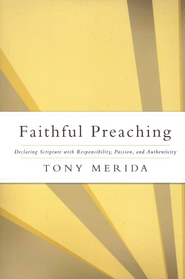
This book review of Tony Merida’s book Faithful Preaching was written as part of Pastor Lane’s doctoral course work, and as such, it is written in a more formal, academic tone than the rest of this blog’s posts. Still, we hope the audience will find these academic book reviews useful, which is why we have published them for your reference.
Tony Merida is lead pastor of Imago Dei Church in Raleigh, North Carolina, and associate professor of preaching at Southeastern Baptist Theological Seminary. He received his Ph.D. in Preaching and a Masters of Theology from New Orleans Baptist Theological Seminary and a bachelors degree in education from the University of the Cumberlands. Prior to moving to North Carolina he served as pastor of Temple Baptist Church in Hattiesburg, Mississippi, as well as Dean of the Chapel and Assistant Professor of Preaching at New Orleans Baptist Theological Seminary. He is also the author of Orphanology.

The purpose of this book is to engage a younger generation of aspiring and beginning preachers to establish a strong start toward faithfulness by giving an introductory overview of theological, practical, spiritual, historical, and missiological foundations of preaching and preachers. While this book is primarily aimed at younger pastors to be able to read and understand, it is the desire of the author that more seasoned pastors would benefit from it as well.
Dr. Merida is a conservative evangelical pastor, scholar and theologian who while young has accomplished a great deal of work and influence in his ministry so far by preaching, teaching, and writing. This conclusion is drawn from his writings, the institutions he has been a part of, and currently represents.
The significant contribution of this book is found in its orientation toward younger ministers. This book is written by a younger pastor and scholar with very adept ability to connect with young, aspiring pastors in training. Regarding this, his writing style, content, and perspective is familiar to and more easily embraced to influence younger pastors. Another significant contribution is the “perspective from within” this generation that the author’s commentary provides. This is the case in reflecting on modern practices that are currently going in the author’s generation. This is also the case in addressing classical areas of importance and concern for preaching, but from one within the generation who is skilled and prepared, but still early in ministry. It is one thing for an older, more experienced pastor, scholar, theologian to offer commentary on newer practices of the leaders, churches, and culture, but to read the perspective of a leader from within that generation brings a fresh perspective and insightful understanding. This book has the beginnings of a long history of training and influencing pastors for several generations. That’s significant.
A general overview of the content reveals a classic preaching book format and structure for an introductory “How-To”. The thematic sectional headings include “Faithful to the Triune God” that covers a Trinitarian foundation for preaching. The second section addresses the fundamentals of Scripture study and sermon preparation. The third section addresses the preacher’s call and preparation or personal life. The fourth section addresses the mission of preaching. Other helpful resources in the appendix include sermon outline sheets and evaluation forms.
Faithful Preaching begins with a classic introductory chapter that draws from the presence and influence of great, prior generation preachers and connects the present to the past by identifying and introducing the reader to influential preachers and writers, most obvious through the title itself “On Preaching and Preachers.” From the start it addresses a surface issue that many young preachers get caught up in and are working through, the non-typical identity of a modern pastor, and leads the reader to greater matters of significance, the responsibility of preaching. The content of this introductory chapter helps to frame the reader by asking the right questions, like “What is a preacher?”, “What is preaching?”, “What is expository preaching, its benefits and dangers?”, and seeking correct, informed answers. This introduction establishes reader context of expository preaching for the remainder of the book by expanding on the benefits and dangers. I think this list of benefits and dangers is both comprehensive and strong.
A Trinitarian foundation is established for expository preaching by identifying the purpose of preaching for God’s glory, the person of preaching as Jesus Christ and the power of preaching by the Holy Spirit. In the second chapter God’s glory is celebrated as the high purpose of preaching. The author affirms his own conviction of this, and then offers three tests for the reader to consider: the test of motive, message, and manner. These are excellent summaries that both encourage and help the reader make direct application in establishing personal convictions for preaching.
The third chapter addresses preaching Christ from inspired Scriptures. The nature of holy Scripture is exposed through inspiration, authority, revelation, and sufficiency. Once the Scriptures are established, the author immediately moves to the centrality of Christ in all the Scriptures. This chapter has a strong Christocentric focus by combining an understanding of the scriptures and Jesus’ place among them together in one chapter. This serves as a great help for young pastors.
The fourth chapter addresses the relationship of Holy Spirit to the preacher and preaching. C.A.L.L. is an acrostic the author uses to emphasize the work of the Spirit in the life of the preacher by confirmation, aspiration, lifestyle, and leadership gifts. The role of the Spirit in preaching is highlighted by the need for, the nature of, and the necessities for obtaining the Spirit’s power. This chapter gives a strong overview of the role of Holy Spirit in the preaching event, as well as equips the reader to seek the Spirit’s power for preaching. The steps offered for seeking the Spirit’s power are helpful to show how real preparation for preaching begins in personal holiness, depends completely upon God’s work through us, and includes congregational participation.
The second section covers faithfulness to God’s Word in preparing the sermon by including study, a unified redemptive theme, sermon construction, developing the elements of the sermon, and adding an introduction and conclusion. In the fifth chapter, seven guiding principles are given and explained to guide a proper study of the text. Following these principles, a practice of study utilizing the principles in phases is given. Teaching faithful principles by guiding practices in this manner is an excellent way to equip and train.
Chapter six shows the reader how to unify the redemptive theme of the text from which to identify the main point of the text and develop the main point of the sermon. The strength of this chapter is that this is the crux of sermon preparation. This chapter makes simple and understandable a process that is not always that simple. But without this crucial step, the sermon can only remain cloudy and muddled. This is critical work for clarity in the sermon.
Chapter seven covers the steps to constructing an outline. Again, principles are given and then followed by a practice in which the reader can apply the principles. This again serves as a great help for the reader.
Chapters eight and nine guide the reader to develop the functional elements of the sermon, like what and when to explain matters and best uses for application and illustration, and then complete it with an appropriate introduction and conclusion. This is most helpful to guide a young pastor in not getting sidetracked in preparation by secondary study or non-essential matters pertaining to the sermon. As well, it clarifies what needs to be explained and applied, and inadvertently what does not. The cautions given for illustrations are wise. I would add one further caution under sensible use of illustrations, to not allow the illustration to dominate the message, but simply to illustrate it. This is a great danger in the conveniently available, media saturated world we live in, especially through the use of video and film. The experiential nature of these media can quickly dominate and distract a listener from the point that is being illustrated.
The fourth section addresses faithfulness to the call of God in the personal life of the preacher regarding training, character, and dependent power through one’s prayer life. Chapter ten commends the reader to train oneself for godliness. The strength of this chapter is that it covers the spiritual and physical life of the preacher. This has been too often a discipline lost among preachers, resulting in a health crisis that really demonstrates a spiritual one among preachers.
Chapter eleven addresses the character and intentional spiritual pursuit of the preacher. Identifying the apparent void of biblical masculinity in the world and in the church, the man of God will stand out in the world. How essential this chapter is in our time, especially for younger preachers, many of whom will have been raised without a father, and so many who had a father without the influence and example of a godliness. The life of a godly man is defined by what he flees and follows after. A preaching ministry heightens a greater need for these disciplines. Chapter twelve addresses faithful praying by identifying its content and hindrances. Along with the marks of a man of God, the prayer life of that man is critical and will remain one of the most challenging to maintain and cultivate. The subtle, ever-present deception of ministry is that “nothing justifies the absence of prayer like God’s work.”
The final section covers faithfulness to God’s mission through preaching the gospel in our generation, faithful contextualization, and raising up leaders. Chapter thirteen covers the event of preaching and includes many practical elements of preaching, like style of preacher, variety in differing elements of voice, rate, pitch, and inflection as well as body language and posture. These elements are important because they will both make all the difference in communication and can potentially become distracting, thereby preventing effectiveness in communication. There is also much wisdom to be gleaned by considering what the author calls communication aides. A young preacher must learn to listen to wisdom of those who have gone before in order to develop a personal philosophy on these matters. Finally the author uses Aristotle’s essentials of logos, pathos, and ethos to identify persuasive speech techniques. This is an excellent framework to thinking through these issues and developing a strategic approach to them.
Chapter fourteen on preaching and contextualization exposes the challenge of communicating in the context while remaining faithful to the Word. Too often too little thought is given to this and causes a message to seem irrelevant. On the other hand, relevance is pursued at the expanse of faithfulness and lacks any gospel-distinct message. This balance must be intentional for a preacher to be effective.
The final chapter on passing the baton offers a compelling historical survey of faithful preaching and compels the reader to give serious and intentional consideration to remaining faithful in the tradition of those who have gone before.
I appreciate the writing style of the author as it was easy for me to read, follow, see the trajectory of content and review. Throughout this book I most appreciated the author’s inclusion of guiding the application and practice of principles after introducing them. To me this is the best way to reinforce and remember what has been read. I am also excited to watch how this book will develop and be used to train future generations. I think it is that caliber of writing. And surely as I read it all I believe it achieved its purpose.
More book reviews by Pastor Lane